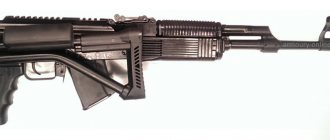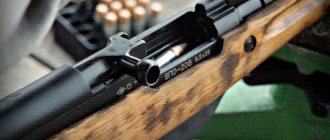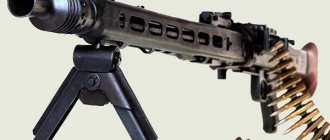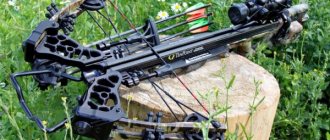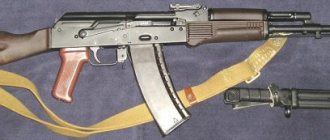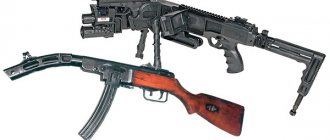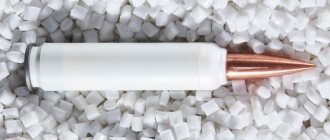Content
- 1. History
- 2 Interesting facts
- 3 Notes
- 4 Links
For the term "Lancaster" see also other meanings.
Lancaster drill
- a type of oval-helical drilling of the bore of a smooth-bore weapon, in which there are only two wide grooves in the barrel, the edges of which gradually turn into fields, and because of this the bore visually appears not round, but oval. In this case, the “oval” does not run straight along the barrel, but reproduces a certain number of turns, similar to rifling. In such a barrel, the bullet acquires a moment of rotation, which significantly increases the accuracy and accuracy of shooting [1].
The absence of a relief cross-section typical of a rifled weapon gives several significant advantages[1]:
- Ease of care for a weapon barrel, which is not leaded for a long time, is quickly cleaned, requires a minimum of attention and retains the advantages of the initial battle for a considerable time.
- Maintaining good performance with shot and excellent accuracy with bullets.
- The overall smoothness of the bore contributes to the strength of the barrel walls, and hence to a reduction in the overall weight of the weapon.
- The absence of relief outlines in the barrel leads to a decrease in frictional forces and an increase in the initial speed of the bullet.
- In addition to all of the above, due to the absence of rifling marks on the side parts of the bullet, the initial rotational moment of the bullet’s momentum is better preserved in flight, which has a positive effect on accuracy.
Initial data
Two trunks took part in the study. A rifled barrel from the Voron.ru company (as far as I know, the company no longer exists), 345 mm long, 13 right-hand rifling. The second barrel is smooth, made by Neva-Target, 405 mm long. The tests were carried out at a temperature of +26 (at home), the shooting distance was 7 meters. The shooting was carried out from one magazine, the speed was 146 m/sec, the number of shots in each approach was different. The shooting was carried out from point blank range.
Story
In 1850, the idea of oval helical drilling
was embodied in metal by the British gunsmith Charles Lancaster and later received his name[2][3]. The original design was patented in the United Kingdom under number 13161 of 1850[4], and a patent for the production equipment was also received the following year[3]. In order to popularize and further develop this technology, an experimental model was created in the form of a 68-pound artillery gun with an oval-helical drilling of the barrel channel. Tests of this system took place at the Royal Arsenal (English)Russian. in Woolwich and caused increased interest in systems with an oval-elliptical trunk cross-section [2]. After a number of improvements and modifications, C. Lancaster received a patent for the final version of drilling in 1867[4].
There is also information about the use of a similar drill at the beginning of the 19th century by the English gunsmith Contriner[1].
Notes
- ↑ 1 2 3 Markevich V. E.
Bullet shotguns. Lancaster drill // Handguns / Under the general editorship of N. L. Volkovsky. - St. Petersburg: Polygon Publishing House LLC, 2005. - P. 274. - 496 p. — ISBN 5-89173-276-9. - ↑ 12
[www.gracesguide.co.uk/Charles_William_Lancaster Charles William Lancaster] (English). Grace's Guide to British Industrial History. Retrieved February 6, 2016. - ↑ 12
Charles Lancaster // Hunting weapons of the world. Encyclopedia. Firearms. Hunting ammunition. Bladed weapons / Malov O.L., Kopeiko E.G., Aksenov N.V., Blum A.M. - OLMA-PRESS, 2003. - P. 42. - 735 p. — ISBN 5-224-03153-2. - ↑ 1 2 Maxim Efimov.
[www.zatrofeem.ru/articles/?id=98/ Charles Lancaster] (Russian).
Information portal www.zatrofeem.ru
. Retrieved February 9, 2016.
Links
Mechanisms for locking and unlocking the barrel bore Wedge locking · Shutter misalignment · Locking with lugs · Shutter rotation · Lever locking · Crank locking · Roller locking · Barrel misalignment · Locking with powder gases · Locking with a blowback bolt · Locking with a semi-blowback bolt Cartridge feeding mechanism Store feed Box magazine · Drum magazine · Disc magazine · Screw magazine · Hopper magazine Belt feed Cartridge strip · Tape feeding mechanism Mechanisms for feeding cartridges into the chamber Direct feed · Indirect feed Mechanism for removing cartridges (cartridges) Main details Ejector Reflector Trigger mechanism Types of trigger mechanisms Trigger firing mechanism · Striker firing mechanism · Continuous fire trigger mechanism · Single fire trigger mechanism · Self-cocking firing mechanism Main details Striker · Trigger · Mainspring · Striker (weapon) · Sear · Trigger · Disconnector · Self-timer · Safety
Results - Gladky
On target No. 4 the barrel is changed, the smoothbore enters the battle. Single shooting. There are 7 holes in 10k, 6 in 9k, one hole in 3k.
From target No. 5 it was decided to switch to shooting in threes. Three bursts tore out a piece of 10 and left three hits in 9.
Target No. 6 also shoots in threes. 4 bursts of which one bullet is in 7k, 4 in 9k, everything else is in 10k.
When shooting at target No. 7, I changed the magazine, so to speak, outside the competitive display. Store 170m/sec. Here there is one entrance each at 6 and 8, the rest entered in a bunch at 9-10.
Excerpt characterizing Drill Lancaster
Pierre blushed the same way he always blushed at this, and hastily said: “I’ll tell you someday how it all happened.” But you know that it's all over and forever. - Forever? - said Prince Andrei. – Nothing happens forever. – But do you know how it all ended? Have you heard about the duel? - Yes, you went through that too. “The one thing I thank God for is that I didn’t kill this man,” said Pierre. - From what? - said Prince Andrei. – It’s even very good to kill an angry dog. - No, killing a person is not good, it’s unfair... - Why is it unfair? - repeated Prince Andrei; what is just and unjust is not given to people to judge. People have always been mistaken and will continue to be mistaken, and in nothing more than in what they consider just and unjust. “It is unfair that there is evil for another person,” said Pierre, feeling with pleasure that for the first time since his arrival, Prince Andrei became animated and began to speak and wanted to express everything that made him what he was now. – Who told you what evil is for another person? - he asked. - Evil? Evil? - said Pierre, - we all know what evil is for ourselves. “Yes, we know, but the evil that I know for myself, I cannot do to another person,” Prince Andrei said more and more animatedly, apparently wanting to express to Pierre his new view of things. He spoke French. Je ne connais l dans la vie que deux maux bien reels: c'est le remord et la maladie. II n'est de bien que l'absence de ces maux. [I know only two real misfortunes in life: remorse and illness. And the only good is the absence of these evils.] To live for yourself, avoiding only these two evils: that is all my wisdom now. – What about love for one’s neighbor, and self-sacrifice? - Pierre spoke. - No, I cannot agree with you! To live only in such a way as not to do evil, so as not to repent? this is not enough. I lived like this, I lived for myself and ruined my life. And only now, when I live, at least try (Pierre corrected himself out of modesty) to live for others, only now I understand all the happiness of life. No, I don’t agree with you, and you don’t mean what you say. Prince Andrei silently looked at Pierre and smiled mockingly. “You’ll see your sister, Princess Marya.” You’ll get along with her,” he said. “Maybe you’re right for yourself,” he continued, after a short silence; - but everyone lives in their own way: you lived for yourself and you say that by doing this you almost ruined your life, and you only knew happiness when you began to live for others. But I experienced the opposite. I lived for fame. (After all, what is glory? the same love for others, the desire to do something for them, the desire for their praise.) So I lived for others, and not almost, but completely ruined my life. And since then I have become calmer, as I live only for myself. - How can you live for yourself? – Pierre asked heatedly. - And the son, and the sister, and the father? “Yes, it’s still the same me, it’s not others,” said Prince Andrei, but others, neighbors, le prochain, as you and Princess Mary call it, are the main source of error and evil. Le prochain [Neighbor] are those, your Kyiv men, to whom you want to do good. And he looked at Pierre with a mockingly defiant gaze. He apparently called Pierre. “You’re kidding,” Pierre said more and more animatedly. What kind of error and evil can there be in the fact that I wanted (very little and poorly fulfilled), but wanted to do good, and at least did something? What evil can it be that unfortunate people, our men, people just like us, growing up and dying without any other concept of God and truth, like ritual and meaningless prayer, will be taught in the comforting beliefs of a future life, retribution, reward, consolation? What evil and delusion is it that people die from illness without help, when it is so easy to help them financially, and I will give them a doctor, and a hospital, and a shelter for the old man? And isn’t it a tangible, undoubted blessing that a man, a woman and a child have no rest day and night, and I will give them rest and leisure?...” said Pierre, hurrying and lisping. “And I did it, at least poorly, at least a little, but I did something for this, and not only will you not dissuade me that what I did was good, but you will also not disbelieve me, so that you yourself do not think so.” “And most importantly,” Pierre continued, “I know this, and I know it correctly, that the pleasure of doing this good is the only true happiness in life. “Yes, if you put the question like that, then that’s a different matter,” said Prince Andrei. - I build a house, plant a garden, and you are a hospital. Both can serve as a pastime. And what is fair, what is good - leave it to the one who knows everything, and not to us, to judge. “Well, you want to argue,” he added, “come on.” “They left the table and sat on the porch, which served as a balcony.
About Lancaster barrel drilling
The English gunsmith and manufacturer Charles William Lancaster is mainly known to hunters and gun enthusiasts as the inventor of gun barrels with a channel of an oval cross-section and a helical rotation of these sections along the length of the channel.
Thanks to this arrangement of the barrel bore, it was possible to fire elongated cylindrical-conical bullets from it. The barrel's large enough caliber made it possible to shoot shotguns as well. Such versatility of the weapon earned it popularity in its time, especially among travelers, who were always limited in the quantity and weight of equipment. But that was not all that was limited to what was called Lancaster firearms.
According to the description of the privilege granted by the English government to the manufacturer Lancaster in 1851, his invention consists of:
- in the idea of a special device for the firearms channel;
- in adapting machines (machines) for the production of handguns of this system;
- in the design of machines for drilling the channel of artillery guns of this system.
In the mid-19th century, artillery still fired spherical shells from guns with smooth cylindrical channels. Therefore, in order to increase the efficiency of the high-explosive effect of bomb shells from cannons in fortresses and on battleships, it was necessary to constantly increase their caliber, sometimes bringing it up to 800 mm. Accordingly, the weight of the gun and its machine increased incredibly. The development capabilities of smoothbore artillery have reached their limit.
However, already at this time, the leading industrial countries adopted weapons with screw-rifled barrels, firing elongated cylindrical-conical bullets, which made it possible to increase the mass of the bullet and the stability of its flight compared to a spherical bullet fired from a smooth cylindrical barrel.
THE FIRST RUBBERS
Screw threading of handgun barrels has been known to gunsmiths since the first half of the 16th century. In particular, the earliest rifled barrels stored in museum weapon collections in Copenhagen, Berlin and Emden date back to 1542, 1549 and 1558, respectively. But the widespread use of rifled weapons in the army as infantry weapons was hampered by the difficulty of loading them from the muzzle. It was necessary to drive the bullet tightly into the bore up to the powder charge, so that upon departure it would turn along the screw rifling, as if along guides.
The situation changed when barrels with screw rifling were invented, allowing a bullet to be freely sent into the barrel chamber through the muzzle.
In Russia, the first such weapon adopted by rifle battalions in 1843 was the “Littich” fitting. Its prototype was a military-style rifled gun designed by Major General Werner of the Brunswick troops. The essence of Werner's invention was that the bullet was sent into a rifled barrel with a gap along the entire length of its channel. This was ensured by two wide screw riflings located opposite each other, which included a special belt of a spherical bullet. In 1848, an oblong pointed bullet with two ears was accepted for the fitting. The technical ideas embedded in the barrels of such fittings prompted artillery gunsmiths to begin improving their guns.
The first state to adopt rifled artillery pieces was Sardinia. By order of the Sardinian government in 1845, a cast-iron rifled bomb cannon was adopted for arming fortresses, the design of which was proposed by Captain Cavalli. In the barrel bore of this gun there were two wide opposite helical grooves (riflings), maintaining the same slope along the entire length of the channel. The cast iron shells of this gun had an external elongated cylindrical-conical shape with two protrusions (ears) at the base. With these lugs, the projectile entered the rifling of the gun channel and moved along it with a gap. At the pointed end of the projectile there was an impact-ignition device.
However, the instruments of this system were not adopted in other states. Thus, by order of the Russian government in 1849, one Cavalli gun was ordered from one of the best iron foundries in Sweden (for Sardinia, Cavalli guns were also ordered in Sweden). The gun exploded on the 6th test shot. The circumstances of the rupture gave reason to believe that it burst due to strong resistance to the movement of the cast-iron projectile as a result of the lugs jamming between the walls of the rifling.
This was not observed in the fittings, since the bullet was made of plastic lead. And the further development and improvement of rifled handguns eliminated the lugs on the surface of their bullets. In particular, bullets began to be made round in cross-section, with a skirt at the base, which expanded under the action of powder gases and was pressed into the rifling of the barrel.
The shape of the bores of artillery guns proposed by Lancaster, according to the author’s idea, eliminated the shortcomings of the bores of the Cavalli system, leading to the jamming of projectiles in the rifling. The essence of the invention of the channel device for Lancaster firearms was to smooth out the corners of the channel section contour with two wide screw riflings used in the “Littich” fitting or Cavalli gun (Figure 1).
This smoothing transformed the angular profile of the section into an oval close to an ellipse. And the internal volume of the barrel channel became similar to screw architectural columns. According to Lancaster, barrel channels with three and four characteristic rifling could also be subjected to a similar transformation. The projectiles for such barrels had to correspond in their cross section to the shape of the barrel section and have some clearance when they were mutually aligned. Jamming of the projectile in the barrel bore was excluded due to the sufficiently long length of support of its side surface against the wall of the bore when fired.
MULTI-FACED TRUNKS
In fact, Lancaster, as a result of his improvements in the rifled bores of the barrels, came to the semblance of polygonal (multifaceted) barrels, which (at least from the beginning of the 17th century) were made from time to time by gunsmiths. Samples of handguns with barrels that are multifaceted in cross-section and spiral in length are stored in many museum weapons collections. In particular, the barrel of an arquebus made by Augustin Kotger in 1618 in Nuremberg had a triangular cross-section of the channel. Two hunting rifles also have a triangular cross-section, one of which is in the collection of the Moscow Kremlin Armory. It was made by master Tsygaev in Tula in 1783. Another gun was made in Tula for Emperor Alexander I. It is in the collection of the Hermitage in St. Petersburg. The quadrangular cross-section of the barrel bore is made from an arquebus made in the first half of the 17th century (State Historical Museum). The hexagonal cross-section of the channel has Russian feeders from the mid-17th century from the collection of the Museum of Artillery, Engineering Troops and Signal Corps in St. Petersburg. At the beginning of the second half of the 19th century, the English gunsmith Whitworth used polygonal channels in his weapons.
The idea of polygonal channels has not left gunsmiths throughout the development of rifled weapons, since with the classical form of spiral rifling, the projectile (bullet), when moving along the bore under the influence of powder gases, rested the side surface of its protrusions on the walls of relatively narrow rifling of the barrel. And with a significant transverse component of the force applied to the projectile as a result of the pressure of the powder gases, it could lead to the projectile breaking off the rifling and its further translational movement without rotation, relative to the direction of this movement. This happened if the projectile material was sufficiently plastic, such as a lead bullet. In this case, when the projectile was made of cast iron, enormous friction arose in the contact zone, leading to its jamming.
Polygonal projectiles during translational-rotational movement had a large contact area with the walls (surface) of the barrel, which could only lead to deformation of the projectile (Figure 2).
Lancaster also noted that the steepness of the screw channel of his barrel could be variable, in contrast to the generally accepted at that time constant inclination of the rifling grooves at three-quarters of a turn along the length of the barrel. He proposed gradually increasing the steepness of the rifling from the breech to the barrel. Starting straight at the breech, the rifling gradually acquired a bend that sharply increased towards the muzzle, acquiring the same angle of inclination as traditional rifling, but making only one quarter of a full turn relative to the axis of the barrel. In addition, Lancaster noted that such a barrel is more convenient to maintain for cleaning from carbon deposits and rust than a classically rifled barrel.
ACCORDING TO THE LANCASTER SYSTEM
In the description of the second point of the privilege of Lancaster’s invention, a description was given of the technology for manufacturing the bores of handguns of his system. Gun and pistol barrels of the Lancaster system were made from ordinary barrel pipes with cylindrical channels, which were flattened in a special way and then twisted. To do this, barrel pipes, rolled and welded from strip iron or prepared using the “Damascus” technology with drilled cylindrical channels, were pulled in flattening rollers, on the contacting surfaces of which semi-elliptical grooves were made. Through the action of such rollers, the pipes were flattened along their entire length, acquiring an elliptical cross-sectional shape of the outer surface and the internal channel. Then, in the same flattening rollers, the elliptical pipes were twisted using a broaching machine. The pipes were grabbed by special flares at the end of the rod of the broaching machine and pulled through a die formed by the grooves of the rollers and turned to the required angle. The rotation of the rod was ensured by the profile screw guide of the broaching machine. The barrel pipes deformed in this way were subjected to further refinement and finishing of the channels on shunting machines, and their outer surface was processed on lathes, and a thread was cut at the breech end for the breech screw.
The channels of artillery guns according to the Lancaster system were processed on a machine specially designed by him for this purpose. Here, as in the case of handgun barrels, completely finished muzzle-loading artillery barrels with smooth cylindrical channels were actually modified.
The principle of operation of this machine was as follows: the tool was fixed on a movable slide, which, using a screw feed, could move along the plane of the machine bed. A boring device with a boring head at the end of a long rod was also mounted on the bed. Before processing began, the rod was inserted into the bore to its bottom and the boring head was set into rotation using an axis passing through the center of the rod along its length. The boring head cutter moved along an elliptical profile. Then they began to move the barrel back from the boring device, while simultaneously turning its rod relative to the axis of the barrel. This rotation changed the position of the long axis of the elliptical movement of the boring head cutter. As a result of the translational movement of the barrel, the elliptical rotation of the cutter edge and the angular rotation of this rotation, the initially cylindrical channel was transformed into a spiral one.
Experiments with polygonal and similar bores ultimately did not lead to the adoption of firearms based on them. There followed rapid progress in the designs of breech-loading hand-held and artillery firearms, which did not require preliminary running of a projectile (bullet) through the bore and the successful use of copper belts on the shells of Krupp rifled guns, thanks to which a balance was found between the plasticity of the projectile surface and the spiral rifling on the cylindrical bore .
Andrey Menkov Russian hunting newspaper 07-1999
